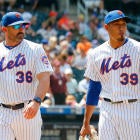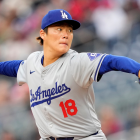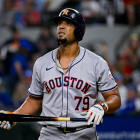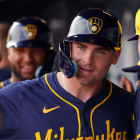Following a molten hot streak soon after the All-Star break that saw them climb back into the wild-card race, the New York Mets have been officially eliminated from postseason contention. Ultimately, a 7-17 stretch in late June and early July sank the Mets -- they were 40-50 with the National League's second worst record at the All-Star break -- and kept them out of the postseason.
Projections by FanGraphs show New York's postseason odds were slim pretty much all season, with only a slight bump in August. Their postseason odds topped out at 53.0 percent on Aug. 10, fourth best in the National League on that particular day (behind the Dodgers, Braves and Nationals):

"We're definitely not satisfied with where we're at," outfielder Michael Conforto told reporters, including NorthJersey.com's Justin Toscano, following the team's elimination Wednesday. "We want to play in October, that's the goal. I think we have the guys in here to do it. We have to put six months of baseball together, and we didn't do that this year."
What's most remarkable about the Mets' postseason-less season is just how much went right this year. Consider:
- 51-homer man Pete Alonso had one of the best rookie seasons in baseball history.
- Jeff McNeil proved to be an elite all-around hitter with great defensive versatility.
- Jacob deGrom put together his second straight Cy Young caliber season.
- Seth Lugo struck out over 100 batters and solidified himself as a true bullpen ace.
- Amed Rosario made strides with both his bat and glove, especially in the second half.
- J.D. Davis had a breakout season and is now the third baseman of the future.
- Conforto stayed healthy all year and set a new career high with 33 homers.
Even without a postseason berth, there was a lot for the Mets to feel good about this season. Of course, there's a lot to feel not-so-good about too. The Robinson Cano/Edwin Diaz trade has been an unmitigated disaster -- Cano had his worst offensive season since 2008 and Diaz has 5.59 ERA -- and 2018 breakout player Brandon Nimmo missed most of the year with a neck injury.
Also, the rotation behind deGrom was a bit suspect. Noah Syndergaard made it clear he doesn't like throwing to starting catcher Wilson Ramos -- that said, Syndergaard's last three starts have all been underwhelming, and he's thrown to three different catchers -- and both Steven Matz and Zack Wheeler were up and down. So was trade deadline addition Marcus Stroman.
| PLAYER | IP | ERA | ERA+ | WHIP | K/BB | WAR |
|---|---|---|---|---|---|---|
Steven Matz | 154 1/3 | 3.99 | 102 | 1.29 | 3.11 | 1.6 |
Noah Syndergaard | 190 2/3 | 4.30 | 95 | 1.24 | 4.02 | 2.2 |
Zack Wheeler | 187 1/3 | 3.99 | 102 | 1.29 | 3.70 | 3.3 |
Marcus Stroman (Mets only) | 53 2/3 | 3.86 | 106 | 1.51 | 2.36 | 1.0 |
Matz, Syndergaard and Wheeler all performed remarkably similar on a rate basis this year. Overall, those four starters combined to give the team 586 roughly league average innings. Average isn't bad, necessarily, but the Mets are built around their rotation, and three of their top four starters coming into the season being average was never going to cut it.
Changes are most certainly coming this season. Wheeler is a free agent -- "I love it here and I definitely would listen to these guys, but I think you have to weigh all your options and see what's best for me personally at that point," he told reporters, including Mollie Walker of the New York Post, when asked about free agency this week -- and a Syndergaard trade has never seemed more likely.
Manager Mickey Callaway, who seems to be in over his head more often than not, is almost certain to be replaced. He was on the hot seat all summer, with only the team's August hot streak keeping him employed. New GM Brodie Van Wagenen seems likely to bring in his own manager next year. A new manager will help, but Callaway is hardly the only problem in Flushing.
Assuming they do not trade Stroman and Syndergaard -- not the safest of assumptions at this point, especially with Syndergaard, but humor me -- the Mets will move forward with a quality core. Alonso, McNeil and Conforto (and a healthy Yoenis Cespedes?) anchor the lineup and deGrom fronts a rotation with potential. There are worse groups to build around.
What must happen for the Mets to return to the postseason next year? Three things stand out.
1. Cano and Diaz have to be better
I suppose the good news is they can't be worse? Cano owns a .261/.310/.436 batting line -- that is five percent below average once adjusted for ballpark -- and is slipping defensively, and, with his 37th birthday a month away, the decline may be irreversible. McNeil is a great second base backup plan, but Cano is owed $96 million the next four years, and the Mets aren't the type to spend money to paper over mistakes. At the very least, Cano needs to be a strong complementary player in 2020.
As for Diaz, his troubles this season are tied mostly to his slider, perhaps because the baseball has changed and he's unable to get the same movement on the pitch. The numbers on his slider are staggering:
| YEAR | AVG ALLOWED | SLG ALLOWED | SWING & MISS RATE |
|---|---|---|---|
2017 | .144 | .231 | 46.5% |
2018 | .129 | .234 | 53.8% |
2019 | .296 | .592 | 43.4% |
The swing and miss rate on Diaz's slider was still really good this year. The problem is when hitters did make contact, they hit the ball extremely hard. His location was not good, and the slider has an affect on his fastball too. The fastball and slider do not exist in a vacuum. They play off each other and hitters don't have to respect the heater as much with a bad slider.
Diaz turns only 26 in March and you needn't look back far to see the last time he was a dominant reliever. Just last year he was arguably the top closer in the game. As long as he's healthy -- we have no reason to believe he's not -- I expect Diaz to figure it out and get back to being great. Things snowballed this year. An offseason to reset could do wonders (the Mets have to hope it does).
The Mets invested a lot -- a lot -- in Cano and Diaz. They took on Cano's contract and gave up two good prospects, most notably outfielder Jarred Kelenic, who MLB.com ranks as the game's 14th best prospect. "He has the kind of offensive profile that could allow him to move a little more quickly than some high school hitters," says their scouting report of the 20-year-old who reached Double-A this year. That stings.
Trading Diaz is an option -- Diaz for Andrew Benintendi, who says no? -- but his value is way down at the moment, and it's hard to believe the Mets will get a fair return. Their best option is keeping him and trying to get him straightened out. The Mets spent way too much capital (prospects and money) to bring in Cano and Diaz. They can't just be along for the ride. They have to help drive the bus to get New York back to the postseason.
2. The bullpen needs reinforcements
Thanks largely to Diaz and Jeurys Familia, the bullpen was a major weakness for the Mets this season. That's even with Lugo being so good and Justin Wilson finishing very strong. The team's bullpen ranks are not good. Not good at all:
- ERA: 5.02 (25th in MLB)
- WHIP: 1.44 (23rd)
- K/BB: 2.40 (17th)
- Shutdowns: 117 (6th fewest)
- WAR: 0.8 (24th)
(Shutdowns are relief appearances that improve the team's win probability at least six percentage points.)
You can survive and even thrive with a bad bullpen -- the 2017 Astros and 2018 Red Sox famously papered over weak relief crews by using their starters as relievers in October, something that seems plausible for this Mets group -- but it's really hard, and a bad bullpen will sink a team on the postseason bubble during the long 162-game season. Example: 2019 Mets.
The Mets cycled through numerous depth arms (Tyler Bashlor, Wilmer Font, Drew Gagnon, Walker Lockett, Chris Mazza) and not a single one provided stability. That group combined to allow 85 earned runs in 113 2/3 innings, or a 6.73 ERA. Five guys combining for a little more than 100 innings may not sound significant, but that's nearly a quarter of the team's relief innings.
I believe Diaz is fixable. Maybe I'm wrong and I'm being overly optimistic, but I think he can be fixed. Familia? Not so sure about him. His control has deteriorated -- forget command, he has problems with basic strike-throwing -- and his stuff has slipped a grade or two. Familia signed a three-year, $30 million contract last winter and might be going all Heath Bell with the Marlins on the Mets.

Diaz, Lugo and Wilson is ostensibly a solid relief core. You can work with that. Three men do not make a bullpen, however. It takes a village and throwing money at the problem isn't always the best solution. Look at Familia, Craig Kimbrel, Kelvin Herrera, so on and so forth. (The Mets aren't known for throwing money at their problems, but you know what I mean.)
Fixing a bullpen is tricky because even the best bullpens can be inconsistent year to year. The best plan is accumulating as many bat-missing arms as possible and seeing who sticks. Those five pitchers mentioned earlier (Bashlor, Font, Gagnon, Lockett, Mazza) combined for a 86 strikeouts in those 113 2/3 innings, or 6.8 K/9. That absolutely will not cut it in today's MLB.
It's not easy to fix a bullpen. Believe me, I know. The Mets thought they built a strong bullpen when they added Diaz, Familia and Wilson over the winter, and they went 1 for 3 with those acquisitions. 1 for 3 is a good day at the plate. It's a bad year for high-priced relief pickups. New York's bullpen was a clear weakness this season and improving it is a must.
3. The pitching depth must improve
This ties into the previous point. As good as the Mets rotation is (at least on paper but mostly in reality), the team isn't blessed with much depth. Righty Justin Dunn (Cano/Diaz trade) and lefty Anthony Kay (Stroman trade) were New York's best and closest to the big leagues pitching prospects when they were traded away. That leaves them short rotation (and even bullpen) options.
The Mets best pitching prospect close to the big leagues is lefty David Peterson, who posted a 4.19 ERA in 116 Double-A innings this year. "Average bat-missing ability and a knack for inducing weak, ground-ball contact points to more of a floor than a ceiling for Peterson," says MLB.com's scouting report. The innings leaderboard for the club's Triple-A affiliate is not promising:
- Drew Gagnon: 88 2/3
- Corey Oswalt: 86 2/3
- Ervin Santana: 82
- Chris Flexen: 78 2/3
- Chris Mazza: 76
Santana is a veteran who will be a free agent, and Oswalt and Flexen are on the 40-man roster but were not given September call-ups, which doesn't bode well for their future with the organization. There is a Dunn-and-Kay-sized hole in the organization's pitching depth chart. If Cano, Diaz and Stroman perform like impact guys, it's easier to swallow, but that hasn't been the case.
Peterson and Tommy John surgery rehabbers Thomas Szapucki and Franklyn Kilome (Szapucki returned this year, Kilome is due to return next year) could be big league factors for the Mets next season. Otherwise Van Wagenen and his staff will have to go outside the organization to build pitching depth, something they did not do especially well in 2019.
The quickest way to build pitching depth would be to trade Syndergaard and/or Stroman, which would be robbing Peter to pay Paul. Sure, you could add several quality young pieces in those trades, but your MLB rotation would be weaker as well. With this core (Alonso, deGrom, McNeil, etc.) the goal should be adding to the big league roster, not subtracting from it.
Another possibility is trading Dominic Smith, who was really good (.278/.352/.506) before a foot injury essentially ended his season in July. Smith is blocked with the Mets -- he is a natural first baseman (Alonso) who has dabbled in left field (Cespedes, Conforto, Nimmo, McNeil) -- and an obvious trade chip who could bring back some arms. The Blue Jays, Red Sox and Royals stand out as first base needy teams and possible trade partners for Smith.
Aside from Davis and Wilson, pretty much everything Van Wagenen did in his first offseason as general manager backfired. The Cano/Diaz trade was a disaster, Familia isn't working out, the starters don't like throwing to Ramos, Jed Lowrie barely played, Keon Broxton (who cost the Mets three prospects!) was a total bust, and releasing Travis d'Arnaud only 25 plate appearances after Tommy John surgery was shortsighted. Lots of bad and not enough good.
To improve next season, one of two things must happen, or preferably both: Van Wagenen needs more hits than misses in Year 2 at the helm, and ownership needs to spend more money. The Mets were again middle of the pack in payroll this year (via Spotrac):
- 2019: $158.8 million (10th in MLB)
- 2018: $150.2 million (12th)
- 2017: $144.0 million (15th)
- 2016: $147.7 million (12th)
Payroll is up approximately $15 million from 2017, which sounds great, except the Mets are receiving insurance reimbursements on Cespedes and David Wright (the exact amount is not known but it is many millions), so the team's effective payroll is lower than that $158.8 million would lead you to believe.
The Mets play in the game's largest market and in a beautiful and relatively new ballpark, and they own their own television network as well, yet they consistently run middle of the pack payrolls. It's a shame. It really is. They should be among the league leaders in spending, which obviously doesn't guarantee success, but it sure as heck can make success easier.
Van Wagenen's first year as general manager was unimpressive. Too many moves backfired, leaving the team with bullpen and pitching depth questions, among other things. The Wilpons are compounding problems with their lack of financial support. deGrom, Alonso, McNeil and Conforto is a core you can win with. The rest of the Mets, including the coaching staff and front office and ownership, leave an awful lot to be desired.






















